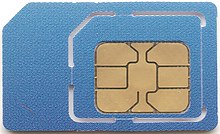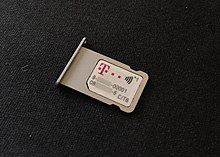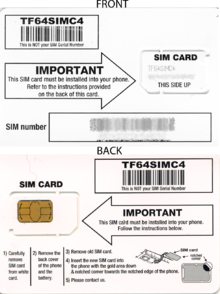

A SIM (Subscriber Identity Module) card is an integrated circuit (IC) intended to securely store an international mobile subscriber identity (IMSI) number and its related key, which are used to identify and authenticate subscribers on mobile telephone devices (such as mobile phones and laptops). SIMs are also able to store address book contacts information,[1] and may be protected using a PIN code to prevent unauthorized use.
SIMs are always used on GSM phones; for CDMA phones, they are needed only for LTE-capable handsets. SIM cards are also used in various satellite phones, smart watches, computers, or cameras.[2] The first SIM cards were the size of credit and bank cards; sizes were reduced several times over the years, usually keeping electrical contacts the same, to fit smaller-sized devices.[3] SIMs are transferable between different mobile devices by removing the card itself.
Technically the actual physical card is known as a universal integrated circuit card (UICC); this smart card is usually made of PVC with embedded contacts and semiconductors, with the SIM as its primary component. In practice the term "SIM card" is still used to refer to the entire unit and not simply the IC. A SIM contains a unique serial number, integrated circuit card identification (ICCID), international mobile subscriber identity (IMSI) number, security authentication and ciphering information, temporary information related to the local network, a list of the services the user has access to, and four passwords: a personal identification number (PIN) for ordinary use, and a personal unblocking key (PUK) for PIN unlocking as well as a second pair (called PIN2 and PUK2 respectively) which are used for managing fixed dialing number and some other functionality.[4][5] In Europe, the serial SIM number (SSN) is also sometimes accompanied by an international article number (IAN) or a European article number (EAN) required when registering online for the subscription of a prepaid card.

As of 2020, eSIM is superseding physical SIM cards in some domains, including cellular telephony. eSIM uses a software-based SIM embedded into an irremovable eUICC.
- ^ Cite error: The named reference
:4was invoked but never defined (see the help page). - ^ Cite error: The named reference
ihswas invoked but never defined (see the help page). - ^ GSMA Intelligence. "Understanding SIM evolution" (PDF). GSMA Intelligence. GSMA. Archived (PDF) from the original on 20 March 2023. Retrieved 31 May 2023.
- ^ "Calling Features on Your Samsung Galaxy Phone". Samsung. Limit Calling to Specific Numbers. Retrieved 19 April 2022.
- ^ "Access codes". Nokia.